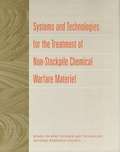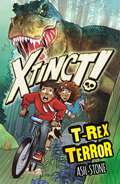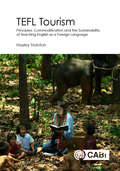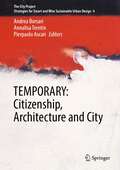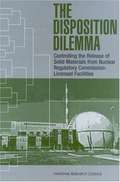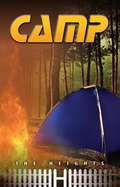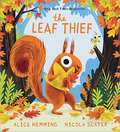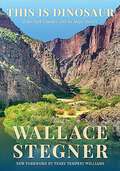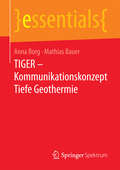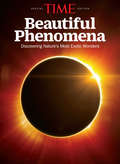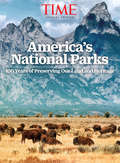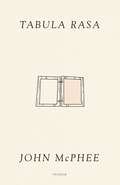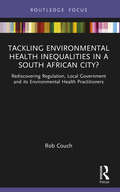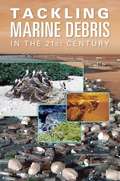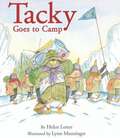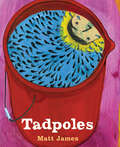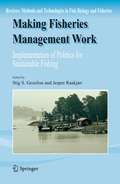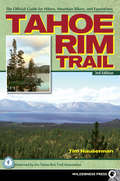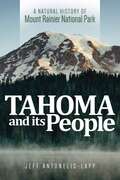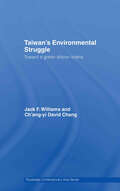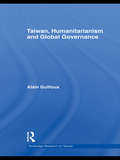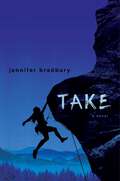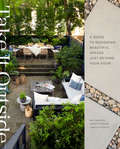- Table View
- List View
Systems and Technologies for the Treatment of Non-Stockpile Chemical Warfare Materiel
by National Research CouncilThe main approach adopted by the U. S. Army for destruction of all declared chemical weapon materiel (CWM) is incineration. There has been considerable public opposition to this approach, however, and the Army is developing a mix of fixed site and mobile treatment technologies to dispose of non-stockpile CWM. To assist in this effort, the Army requested NRC to review and evaluate these technologies, and to assess its plans for obtaining regulatory approval for and to involve the public in decisions about the application of those technologies. This book presents an assessment of non-stockpile treatment options and the application of these systems to the non-stockpile inventory, of regulatory and permitting issues, and of the role of the public.
T-Rex Terror: Book 1 (Xtinct!)
by Ash StoneTo say Jeevan Singh has an unusual life is an understatement. Not many kids his age can say that they have a Neanderthal best friend and a Dodo for a pet. Even fewer could claim to have a rescued a T-Rex!When a freak accident at his Mum's fossil lab brings all sorts of extinct animals back to life, it's up to Jeevan and his new friends to save them before evil Barron Fox captures them...Perfect for fans of Beast Quest, Deadly 60 and Jurassic World, these action-packed adventures will inspire readers to help save endangered species and combat extinction.
TEFL Tourism: Principles, Commodification and the Sustainability of Teaching English as a Foreign Language
by Hayley StaintonThere is evident lineage between the concepts of teaching English as a foreign language (TEFL) and tourism, represented through evocative marketing material, the commoditisation of the TEFL product, teacher motivations and experiences. Yet, to date there has been no recognition of these links within industry or academia. This book introduces the concept of 'TEFL tourism', outlining the scale of the sector and the rapid commercialization of TEFL teaching across the world, locating it as an emerging form of niche tourism. The text outlines the organisation types and geographical locations, emphasizing the commodification of English language teaching. It also outlines the types of TEFL tourists, the complexities of international education, links with various tourism forms and sustainability considerations of the industry. Key features include: - The first book of its kind - Case studies throughout add context to the theoretical presentation of the industry - Presents relevant industry statistics - Addresses sustainability and stakeholders. The book will appeal to tourism academics and students, in particular those with interests in educational and volunteer tourism as well as sustainable tourism and commodification.
TEMPORARY: Citizenship, Architecture and City (The City Project #4)
by Andrea Borsari Annalisa Trentin Pierpaolo AscariThis book offers a comprehensive overview of forces shaping urban renewal and the sustainable and inclusive transformation of contemporary cities. It discusses temporariness and uncertainty of citizenship, participation, and inclusion, as well as the energy and digital transformation, merging different perspectives, such as the social, philosophical, economic, and architectural ones. Based on revised and extended contributions to the International Congress “TEMPORARY: Citizenship, Architecture and City", held virtually on November 20-21, 2022, from the University of Bologna, this book offers extensive information and a thought-provoking reading to researchers in architecture, anthropology, social and environmental policy, as well as to professionals and policy makers involved in planning the city of the future.
THE DISPOSITION DILEMMA: Controlling the Release of Solid Materials from Nuclear Regulatory Commission-Licensed Facilities
by Committee on Alternatives for Controlling the Release of Solid Materials from Nuclear Regulatory Commission-Licensed FacilitiesA report on Controlling the Release of Solid Materials from Nuclear Regulatory Commission-Licensed Facilities
THE HEIGHTS: Camp
by The Editors at the Saddleback Educational PublishingThese traditional reads are brimming with spirited characters and positive values- but with a little extra excitement and bite, so hold on to your hats! Written expressly for the middle grade struggling reader, the series does not contain strong language, edgy themes, or dysfunctional families. In fact, family is the main theme of these titles. And one particular Latino family is the focus with their uncanny knack for finding humor, hope, and coloful personalities- even in unusual circumstances. Written at the lowest reading levels, the 50-page story structure is straightforward and moves the reader through the text quickly and efficiently.
THE LEAF THIEF (A\squirrel And Bird Book Ser.)
by Alice HemmingA New York Times Bestseller! Perfect for fans of Fletcher and the Falling Leaves, The Leaf Thief is a funny picture book that teaches kids about autumn, adapting to change, and the seasons. Squirrel loves counting the leaves on his tree--red leaves, gold leaves, orange, and more. But hold on! One of his leaves is missing! On a quest to find the missing leaf, Squirrel teams up with his good friend Bird to discover who the leaf thief could be among their forest friends.
THIS IS DINOSAUR: Echo Park Country and Its Magic Rivers
by Wallace Stegner Terry Tempest WilliamsThis Is Dinosaur was first published in 1955, in the midst of a bitter controversy over the proposed construction of dams at Echo Park. The outcome of the controversy--a congressional vote to prohibit the dams--"set in brass the principle that any part of the national park system should be immune from any sort of intrusion and damage," wrote Wallace Stegner in the 1985 edition of the book. Reprinted with new color photographs, This Is Dinosaur still stands as a classic introduction to the historic, scenic, archeological, and biological resources of the Monument by an impressive array of writers.
TIGER – Kommunikationskonzept Tiefe Geothermie (essentials)
by Anna Borg Mathias Jürgen BauerDas vorliegende Kommunikationskonzept unterst#65533;tzt Investoren, Betreiber und Institutionen bei der #65533;ffentlichkeitsarbeit und Kommunikation f#65533;r den Bereich Tiefe Geothermie und zeigt Wege auf, die Akzeptanz f#65533;r das lokale Projekt zu f#65533;rdern. Es geht auf den Auftrag des durch das Bundesministerium f#65533;r Wirtschaft und Energie (BMWi) gef#65533;rderten Forschungsprojektes ,,TIGER - Tiefe Geothermie: Akzeptanz und Kommunikation einer innovativen Technologie" zur#65533;ck.
TIME Beautiful Phenomena: Discovering Nature's Most Exotic Wonders
by The Editors of TIME MagazineYour guide to the science of eclipses, rainbows, volcanoes, and nature's many wonders.Powerful and dramatic, the natural wonders of our earth dazzled our ancient ancestors-and continue to inspire awe in us today. Now, the Editors of TIME capture these amazing sights and occurrences in an all-new special edition, Beautiful Phenomena, pairing glowing photographs with clear, authoritative text that explains the how, what, why, and when of nature's wonders, including eclipses, rainbows, lightning, supermoons, auroras and so much more. Learn about the scientific breakthroughs that came from observing solar eclipses and other natural phenomena over the centuries . . . and discover the latest theories about them that are emerging today. In space, in the oceans, on the land, these natural wonders hold the keys to our understanding of the world around us. Unlock their mysteries with TIME Beautiful Phenomena.
TIME Our National Parks at 100: 100 Years of Preserving Our Land and Heritage
by The Editors of TIMEAs the National Park Service marks its 100th birthday in 2016, TIME celebrates America's spectacular, unspoiled natural treasures. Vast in scale at nearly 85 million acres, the park system stretches from Acadia park in Maine to War in the Pacific park on Guam and more than 400 parks in between, visited by 280 million people each year. Highlights of this special edition:Jewels in the crown: a lavish pictorial tour of the most breathtaking parks, including Yosemite, Yellowstone, Grand Canyon, Glacier and Grand TetonFounding fathers: the idea of a national park began with Western painter George Catlin and was later embraced by President Teddy Roosevelt after three nights under the stars in Yosemite ValleyA visitor's guide to the best of the parks and monuments, from the spectacular to the quirky
Tabula Rasa: Volume 1
by John McPheeA literary legend’s engaging review of his career, stressing the work he never completed, and why.Over seven decades, John McPhee has set a standard for literary nonfiction. Assaying mountain ranges, bark canoes, experimental aircraft, the Swiss Army, geophysical hot spots, ocean shipping, shad fishing, dissident art in the Soviet Union, and an even wider variety of other subjects, he has consistently written narrative pieces of immaculate design.In Tabula Rasa, Volume 1, McPhee looks back at his career from the vantage point of his desk drawer, reflecting wryly upon projects he once planned to do but never got around to—people to profile, regions he meant to portray. There are so many examples that he plans to go on writing these vignettes, an ideal project for an old man, he says, and a “reminiscent montage” from a writing life. This first volume includes, among other things, glimpses of a frosty encounter with Thornton Wilder, interrogative dinners with Henry Luce, the allure of western Spain, criteria in writing about science, fireworks over the East River as seen from Malcolm Forbes’s yacht, the evolving inclinations of the Tower of Pisa, the islands among the river deltas of central California, teaching in a pandemic, and persuading The New Yorker to publish an entire book on oranges. The result is a fresh survey of McPhee’s singular planet.
Tackling Environmental Health Inequalities in a South African City?: Rediscovering Regulation, Local Government and its Environmental Health Practitioners (Routledge Focus on Environmental Health)
by Rob CouchSouth Africa is widely recognised as a middle-income, industrialised nation, but it also ranks amongst the most unequal countries in the world in terms of its income distribution and human development. Environmental health remains a considerable public health challenge in the 21st century as Environmental Health Practitioners (EHPs) try to tackle local environmental health inequalities in the face of historically disadvantaged populations suspicious of their motives and demands that far exceed any resources available. Based on an empirical research project that explores how local government Environmental Health Practitioners regulate environmental health in one of South Africa’s largest, fastest growing and most unequal cities, Urbington, this book explores the many influences on their decision-making including the limits of the law, organisational controls, the views of EHPs themselves and their relations with businesses, communities, politicians and others. Tackling Environmental Health Inequalities in a South African City? argues that if we are to meet the environmental health challenges of the 21st century, it is in our best interests to rediscover this vital local public health workforce. This book is essential reading for students, practitioners and policymakers in environmental health and public health, as well as those interested in urban development and policy, particularly in African cities.
Tackling Marine Debris In The 21st Century
by National Research Council of the National AcademiesMarine debris from ships and other ocean-based sources-including trash and lost fishing gear-contributes to the spoiling of beaches, fouling of surface waters and the seafloor, and harm to marine animals, among other effects. Unfortunately, international conventions and domestic laws intended to control marine debris have not been successful, in part because the laws, as written, provide little incentive to change behavior. This book identifies ways to reduce waste, improve waste disposal at ports, and strengthen the regulatory framework toward a goal of zero waste discharge into the marine environment. Progress will depend on a commitment to sustained funding and appropriate institutional support. The Interagency Marine Debris Coordinating Committee should, through planning and prioritization, target research to understand the sources, fates, and impacts of marine debris. It should support the establishment of scalable and statistically rigorous protocols that allow monitoring at a variety of temporal and spatial scales. These protocols should contain evaluative metrics that allow assessment of progress in marine debris mitigation. The United States, through leadership in the international arena, should provide technical assistance and support for the establishment of additional monitoring and research programs worldwide.
Tacky Goes to Camp
by Helen Lester Lynn MunsingerTacky and his fellow penguins are off to summer camp in Nice Icy Land to enjoy themselves while Rock Hopping, Line Dancing, and playing Capture the Ice Cube. One night, they gather around the campfire to sing, eat s'mores, and tell scary stories. But after going to bed, something straight out of one of their scary stories pays the sleeping penguins a visit. Goodly, Lovely, Angel, Neatly, and Perfect think they should high-tail it out of there, but it is Tacky-with some unexpected heroics-who saves the day.Includes lyrics to the official Camp Whoopihaha song!
Tactical Combat Casualty Care and Wound Treatment
by U.S. Department of DefenseMilitary surgeons must assume a leadership role in combat casualty care in circumstances that are far less than ideal. This handbook provides much of the information needed to tackle these issues and features state-of-the-art principles and practices of forward trauma surgery as used by military physicians in far flung locations around the globe. In this volume you’ll learn such integral skills as: * Tactical field care * Field dressing * Applying pressure dressing * Treating burns * Treating inhalation injuries * And more! Tactical Combat Casualty Care and Wound Treatment is the most trusted and up-to-date manual offered by the Department of Defense for military medical personnel in the field.
Tadpoles
by Matt JamesOne rainy morning, a father and son bond over a walk through a field full of freshly formed ponds teeming with tadpoles.In this tender reflection on the fleeting rhythms of the natural world and the enduring love of family, a boy and his father spend a morning exploring an ephemeral pond, a delicate nursery formed by rainfall, perfect for sheltering tadpoles from predators as they grow. The boy&’s father doesn&’t live with him anymore, and the ponds may only be temporary, but together they make memories that just might last a lifetime. With Tadpoles, Boston Globe-Horn Book Award winning author and illustrator Matt James draws from his own memories as a parent and as a child to tell a wistful story that will be instantly recognizable to any families sharing memories of exploring together. For an extra treat, additional material at the back of the book enthusiastically outlines the habitats and life cycles that make up these special amphibian spaces. A Junior Library Guild Gold Standard Selection
Tagging and Tracking of Marine Animals with Electronic Devices
by Alistair Hobday Molly Lutcavage Haritz Arrizabalaga Nuno Fragoso Jennifer L. Nielsen John SibertThe 2nd international tagging and tracking symposium was held in San Sebastian, Spain, in October 2007, seven years after the first symposium was held in Hawaii in 2000 (Sibert and Nielsen 2001). In the intervening seven years, there have been major advances in both the capability and reliability of electronic tags and analytical approaches for geolocation of tagged animals in marine habitats. Advances such as increased data storage capacity, sensor development, and tag miniaturization have allowed researchers to track a much wider array of marine animals, not just large and charismatic species. Importantly, data returned by these tags are now being used in population analyses and movement simulations that can be directly utilized in stock assessments and other management applications. Papers in this volume are divided into three sections, the first describing insights into behavior achieved using acoustic, archival, and novel tags, the second reporting on advances in methods of geolocation, while the final section includes contributions where tag data have been used in management of marine species. Accurate documentation of animal movements and behaviors in critical marine habitats are impossible to obtain with other technologies. The management and conservation of marine species are critical in today's changing ocean environment and as electronic tags become more accurate and functional for a diversity of organisms their application continues to grow, setting new standards in science and technology.
Tahoe Rim Trail
by Tim HausermanThe 165-mile Tahoe Rim Trail is considered one of the world's premier trails. Accessible by hikers, equestrians, skiers and mountain bikers (for the non-wilderness portions), it winds completely around spectacular Lake Tahoe, the highest and largest alpine lake in North America. The trail crosses through six counties, three national forests, and two states and was completed in 2001 largely by volunteer labor.The best-selling Tahoe Rim Trail has been revised to reflect the latest conditions and routing of the trail and includes information for over 20 miles of new trail. Updated topographic maps depict the entire route, along with the easy (and fun) to read trail directions, the book includes fascinating information on the plants and animals you'll see along the trail, plus essential advice for planning a hike on the TRT, whether it's a day's outing or a 2-week circuit of the entire lake.The first and only how-to guide to this popular trail, it is the official guidebook of the Tahoe Rim Trail Association, whose mission is to improve, maintain and promote the trail.
Tahoma and its People: A Natural History of Mount Rainier National Park
by Jeff Antonelis-LappA magnificent active volcano, Mount Rainier ascends to 14,410 feet above sea level--the highest in Washington State. The source of five major rivers, it has more glaciers than any other peak in the contiguous U.S. Its slopes are home to ancient forests, spectacular subalpine meadows, and unique, captivating creatures. <p><p>In Tahoma and Its People, a passionate, informed, hands-on science educator presents a natural and environmental history of Mount Rainier National Park and the surrounding region. Jeff Antonelis-Lapp explores geologic processes that create and alter landscapes, interrelationships within and between plant and animal communities, weather and climate influences on ecosystems, and what linked the iconic mountain with the people who traveled to it for millennia. He intersperses his own direct observation and study of organisms, as well as personal interactions with rangers, archaeologists, a master Native American weaver, and others. He covers a plethora of topics: geology, archaeology, indigenous villages and use of resources, climate and glacier studies, alpine and forest ecology, rivers, watershed dynamics, keystone species, threatened wildlife, geological hazards, and current resource management. Numerous color illustrations, maps, and figures supplement the text. <p><p>2020 Banff Mountain Book Competition Finalist, Mountain Environment and Natural History category
Taiwan's Environmental Struggle: Toward a Green Silicon Island (Routledge Contemporary Asia Series)
by Jack Williams Ch’ang-yi David ChangTaiwan experienced a highly successful economic transformation in the last 50 years that produced one of Asia’s genuine ‘miracles’ of modern development, in terms of improvement in per capita income and overall quality of material well being for its citizens. The process, though, involved rapid industrialization and urbanization, and breakneck mass consumption, that inevitably resulted in rapid escalation in degradation of the island’s fragile air, water, and land, and produced some of the worst environmental pollution to be found anywhere in Asia This book examines the causes of Taiwan's environmental predicament, engaging in Taiwan's unique geological, geographical, demographical, political, industrial, historical and economic circumstances. In addition, Jack Williams and Ch'ang-yi David Chang assess the efforts of the government, NGOs and private citizens to create a "green" environmentally sustainable island, with a high tech economy based on the silicon chip, the backbone of Taiwan’s highly successful IT industry. Finally the authors discuss what can be done to improve Taiwan's environmental future. As the first commercially available book in English on Taiwan’s environmental problems this is an invaluable read for students and scholars interested in environmental studies, sustainable development and the island of Taiwan.
Taiwan, Humanitarianism and Global Governance (Routledge Research on Taiwan Series)
by Alain GuillouxIn this unique book, Alain Guilloux uses four major elements of governance - namely norms, actors, processes, and outcomes - to examine Taiwan’s national governance as well as its participation in global governance in relation to humanitarian aid. Including case studies on Taiwan’s application to become an observer to the WHO, and its foreign-aid policy and practice dealing with disease outbreaks and natural disasters, Guilloux explores the complexities and dilemmas of providing humanitarian aid to people in need and distress. Taking into account Taiwan's unclear status in the global arena, and how in its efforts Taiwan faces both international isolation and opposition from the People's Republic of China at multiple levels. Taiwan, Humanitarianism and Global Governance will be of interest for scholars of Chinese studies, Taiwan Studies, East Asian politics and International Relations, and environmental politics and humanitarian studies.
Take
by Jennifer BradburyTwo teens uncover a secret hidden in the Cascade Mountains that spans generations, stringing together family skeletons, lost stories, and a discovery of love and self in this tense and emotional young adult thriller.Cara is on the cusp of adventure. Unlike her best friends, she doesn&’t want to go to college, she wants different kinds of challenges. And anyway, home just doesn&’t fit anymore. She is growing distant from her friends and hasn&’t spoken to her father in eons. To make matters worse, her ex-boyfriend and fellow climber, Nat, has popped back into town after breaking up with her over text. So it&’s the perfect time to leave, and she has big plans for a gap year to rock-climb in Patagonia. But when Cara hears that her father is actually missing, things change. While trying to track him down, she discovers a trail of clues centering around the history and life of the legendary mountaineer, outdoorsman, author, and all around dirtbag, Beckett Friedrichs. And unfortunately, the only person who knows enough about Friedrichs to make sense of any of this is Nat. Their search for Cara&’s father will lead into the Cascade Mountains, up a harrowing rock face, and navigating through time as Nat and Cara explore the history of World War II with the impact of Pearl Harbor and its Japanese Incarceration Camps, Cara&’s family, and each other.
Take A Hike! (The Secret World Of Alex Mack #7)
by Cathy East DubowskiTrouble in Paradise The Junior High School Science and Nature Club is sponsoring a weekend camping trip as their end-of-year project. Alex needs the extra credit in science. What she doesn't need are the chaperones-her parents! And just to make the trip a complete disaster, Vince and Dave are loose in the woods, dead- set on nailing the GC-161 kid. With the help of her friends, Alex actually has some fun and gets a little closer to Scott. This trip is looking up...until Kelly leads them off the trail and straight into Vince and Dave's trap! Now Alex has to find a way out of the woods...and out of danger!
Take It Outside: A Guide to Designing Beautiful Spaces Just Beyond Your Door: An Interior Design Book
by Mel Brasier Garrett Magee James DeSantisFrom the hosts of Bravo's Backyard Envy comes a beautifully photographed guide to converting your outdoor space into an enviable oasis, whether you have a backyard, brownstone patio, or three-season porch.Dubbed the "plantfluencers" by the New York Times, Mel Brasier, Garrett Magee, and James DeSantis, owners of the Manscapers landscaping company, do more than plant, mulch, and manicure a garden; they look at the space just as interior designers do a room, considering the aesthetics and the way people live in it. Now they show you how to apply familiar interior design principles to your outdoors, including: • Deciding on a concept to help direct the mood of your space • "Zoning" your space into functional areas, such as for lounging, cooking, or entertaining • Defining the areas with furniture and hardscaping like fencing, decking, pools, planters, pergolas, and pathways • Bringing in the green, including plants that are both functional (privacy shrubs and shade trees) and decorative (pretty perennials, climbers, and textural grasses) • Adding the finishing touches: the pillows, throws, hurricane lanterns, and other details that will make you want to linger long after sunset Plus, you'll have information on hiring a contractor and landscaper and the specific materials and plants the Manscapers love to use in their designs. No matter how big or small your exterior space, this ultimate guide to landscape design will help you bring the comfort of the indoors outside.
